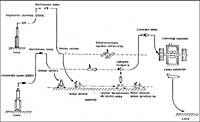Biosphere II: research turned into spectacle
1992/01/01 Uzkudun, Maddi Iturria: Elhuyar aldizkaria
What is Biosphere II?
About 50 km north of the American city of Tucson, in the middle of the Arizona desert, is a unique steel and glass building. It looks like a gigantic greenhouse, a construction of the future. Since September 1991, there have been 8 people (4 men and 4 women) imprisoned in the giant cage. It will take 24 months without leaving. But they are not alone, but coexist with 3,800 different species, both animal and vegetable, in this new box of Noah.
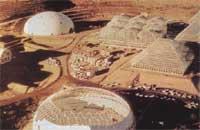
However, the reconstruction of Noah's box has not been a desire of the creators. They go further: they wanted to build the small-scale model of our planet. More specifically, they have built the model of the biosphere, part of the Earth where living beings are, hence the name BIOSPHERE II.
Through the creation of an ecosystem in a closed area, it is expected that we can better understand the behavior of our planet, such as the greenhouse effect or acid rains. Also, air recycling and water purification tests will be carried out with new techniques. And the ultimate goal, the most daring, is to demonstrate that you can live in a closed system and, consequently, be a pioneer and tester of human colonies that will someday settle on the Moon or on Mars. In reality, the Biosphere II project has no official link with NASA or space projects, but if the results of the experience are satisfactory, it will be useful in the design of space bases. In fact, the idea of establishing a base on Mars is no longer a fiction.
What is Biosphere II like?
It looks like a crystal palace or a megancalendario: 170 m long, 110 m wide and 30 m high at the highest point. 12.000 m 2 surface and 200.000 m 3 interior volume. It is hermetically isolated from the atmosphere by glass vault and separated from the ground by a concrete and steel wall. Therefore, the "biologists" inside will breathe their atmosphere, take their water and use it to water the land they will work and eat only food produced by them. In this ecosystem all matter will be recycled and only solar energy will be collected.
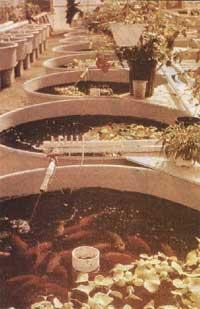
The biosphere ecosystem is a macroecosystem made up of different smaller ecosystems. These smaller systems are the Momas. Therefore, in Biosphere II the main Momas had to be built: jungle, savannah, desert, ocean and swamp. In addition, there is an intensive farming and livestock territory. Finally, the "village" of the Biosphere: rooms, washrooms, library and astronomical observatory, all located in a five-foot module.
The humid rainforest occupies 1,900 m 2. Inside a ginger and banana belt there are 300 different plants and trees and 150 species of insects. In the center is an abrupt mountain 20 m high. The top is very wet, alternately fog and misty. Therefore, the vegetation on the top is different. Next to the jungle is the savannah, composed of 40 different herbaceous species. And who will eat that herb? Zebra and gazelles are not allowed. Instead turtles and termites have been introduced, which also eat the herb in the same way, but need a smaller territory to live.
The desert of the II has an area of 1,400 m 2 and numerous cactus. To build a real desert, the change had to be very large (from 0 ° C to 60 ° C according to the different seasons of the year). Therefore, climate conditions have been sought easier to create and a marine desert has been built, that is, with less alteration and a high rate of air humidity, as what really happens in the Baja California desert in Mexico.
The ocean has a depth of 8 m, including a lagoon and a coral reef. Fish, animals, marine plants,... a total of 1,000 different species. A special machinery affects water and produces waves. Next to it and separated from the saltwater of the ocean, is a reservoir of 3,600 m 2. It has rebuilt the biotope of Everglades in Florida: mangoes, turtles, crabs, frogs, etc. placed.
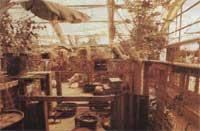
The biome for intensive crops has an area of 2.000 m 2, so the eight biologists must extract the daily food. 150 different plants will be planted alternately. Waste will be treated for use as fertilizer. They cannot use artificial fertilizers or pesticides. Next to the fields and orchards there are barriers to livestock: chickens, dwarf pigs and dwarf goats. Finally there is the fish farm. Tilapia fish are found in the containers. These African fish can live in fresh and salty waters, eating algae that grow with sunlight and heat from the sun.
Not everything is natural
The interior air of Biosphere II is dilated and contracted according to temperature and the glass structure cannot resist pressure variation. Dilation can cause the explosion of construction and even implosion by contraction. To this problem two giant rubber membranes of 28,000 m 3 of external capacity of tea have been placed. These membranes, joined by underground tubes with Biosphere II, regulate atmospheric pressure: by increasing the temperature they swell and when they go down they empty.
2,500 electronic sensors constantly control the atmospheric quality, the degree of humidity, the degree of salinity and evaporation of ocean water, plant growth, etc. The sun level is also controlled through the roof ports. A 5, 5 megawatt underground power plant consisting of three generators has been built to supply power to all the machinery. The waste turbines used to power the generators are natural gas.
This is one of the dark aspects of this ecological project. Why not use solar energy while in the desert? Those responsible have given the reason that this has not been done: money. Only with solar energy would it take 1.8 billion pesetas (100 million pounds) more.
New disneyland?
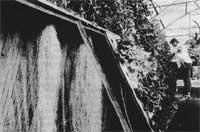
The Biosphere II project, created in 1984, has had about 200 scientists and technicians. It has no official help, it is totally private. One of Texas' oil businessmen, Edward P. Bas included 2.7 billion pesetas (150 million pounds) in the project. And the total cost is estimated at about 13.5 billion pesetas (750 million pounds). Hopefully you intend to recover that amount. How? The answer is simple: Turning the biosphere into a spectacle.
In September 1991, the project was repeatedly unveiled in all TV channels and written media. After this large advertising campaign, the economic exploitation of the Biosphere II project has begun. Every day buses full of tourists arrive to see the new circus. Only in 1991 a million tourists were expected to arrive.
They will pay the entrance and observe the interior, the suboceanic soil, the coral reef, etc. from the glass windows, as in the aquarium. In addition, they will be able to observe through a video camera the rest of corners that can not be seen from outside at first sight, as well as the life of the 8 “bionautas” inside. Finally, they will go through the souvenir shop and buy all kinds of souvenirs. Well thought out, right?
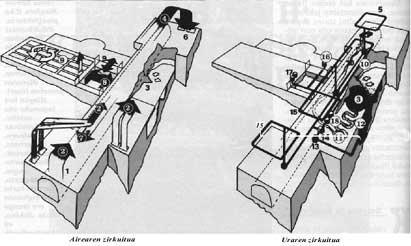
circuit in contact with the hot desert sand (1) is heated and raised by decreasing density (2). It then moves to the ocean (3), increasing evaporation of water. Full of water vapor and heads to the rainforest. In the jungle, when you reach the cooling tower, the water condenses and a rain is formed (figure 5 on the right). When the density is cooled it increases and the air drops to the ground. There (6) fans vacuum and send to the desert through an underground tunnel (7). Part of the tunnel air is diverted to the place of residence of crops, livestock and biosphere. In this area (9) it participates in evapotranspiration and photosynthesis of plants and human and animal respiration.
mount (5) as it rains streams are formed (10) and the water falls down the mountain almost to the level of the ocean. After several meanders (11), fresh water is salted in the swamp (12) and returned to the ocean (3). For all other uses of Biosphere II, the water is collected by a pump (13) from the ocean and the river and taken to the desalination plant (14). Some of the water that leaves is sent to the hygrometry and ambient temperature regulation circuits (15). The other part will be used for population use (16) or for agricultural and livestock use (17), but before its defense the pH will go through the treatment unit (18), bacteria, mineral salts, etc. control.
In June 1991 a group of scientists from the US and the Soviet Union conducted a study at Stanford University in California to calculate the cost of installing a permanent base on Mars. The amount is not so astronomical: 60 billion dollars, that is, more than 6 billion pesetas or about 350 billion pounds. If the United States, the European powers, the Soviet Union and Japan met, the project could begin in 1994. Deadlines have also been established in the study. These are: The current technology would be sufficient to carry out the first phases of the project. The Soviet projector called Energy would serve to place the basic elements of the base in a geostable orbit: on the one hand, the prefabricated houses, two exploration vehicles and a space to carry out the displacements between the orbit of Martitz and the ground of Martitz. On the other hand, a fuel tank should also be orbited. The execution of this first phase is technically simple. In the Earth's orbit the fuel tank and the other elements would unite, but the maneuver of association is no longer new in the orbit. It has been performed several times by Soviet and American astronauts. Then all the elements would start on Mars. They would need some energy to get out of the Earth's orbit, but they would not need energy to travel, as the laws of space mechanics would take them to Mars. After a journey of 9 months they should use engines to brake and introduce them into the orbit of Martitz. Finally, in the pilotable module the astronauts descend to the sky of Mars. All the basic equipment would be placed in Martitz's orbit two years before the astronauts arrived. Once human beings arrived they would make two years of stay on Mars and, later, with a return of 9 months, they would return to Earth leaving space for another team. |

Gai honi buruzko eduki gehiago
Elhuyarrek garatutako teknologia




